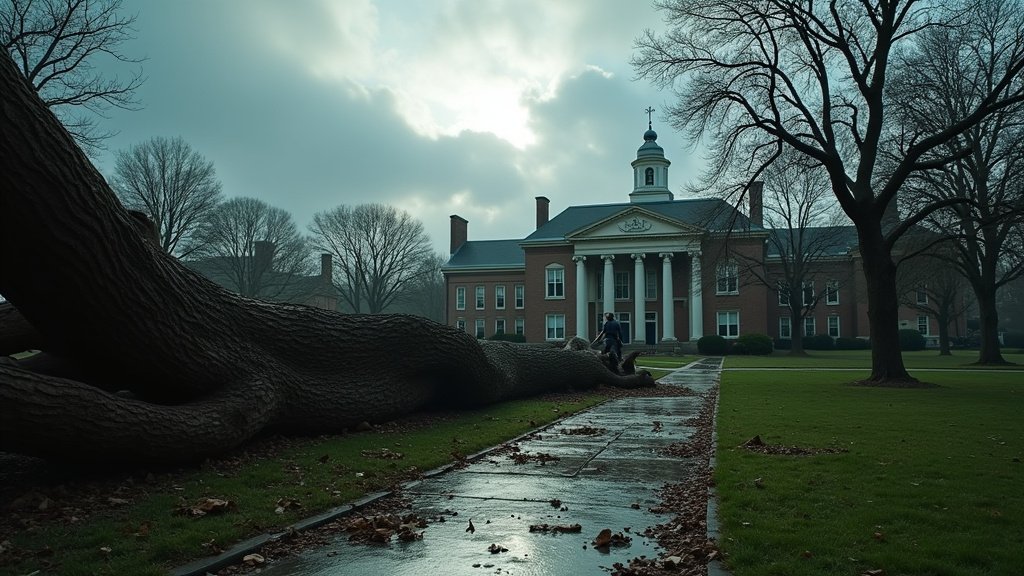EUGENE, OREGON – A former University of Oregon student has filed a lawsuit seeking $16.3 million, alleging severe negligence by the university after a large tree collapsed on her on the Eugene campus, leaving her paralyzed. This University of Oregon Lawsuit details a harrowing incident that occurred on February 24, 2025, during a significant windstorm, marking a critical point in campus safety discussions.
The Day of the Collapse: A Student’s Life Altered by the University of Oregon Lawsuit
According to the lawsuit, Edwards was walking to class when a substantial portion of a roughly 50-foot tree, located near University Hall, unexpectedly snapped and fell directly onto her. The catastrophic event resulted in life-altering injuries, including paraplegia, multiple spinal fractures, internal bleeding, broken ribs, a fractured pelvis, and leg fractures. The immediate aftermath saw her incur $1.3 million in medical expenses, with projections indicating future costs will reach an estimated $5 million. This University of Oregon Lawsuit highlights the devastating impact of the falling tree accident.
The complaint asserts that the University of Oregon failed in its fundamental duty to ensure the safety of its campus. Specifically, the lawsuit claims the university was negligent by not properly inspecting the tree, failing to undertake necessary maintenance or removal of the weakened tree, and neglecting to adequately warn students and staff about the hazardous conditions posed by the inclement weather and the state of the tree. This campus negligence claim is central to the University of Oregon Lawsuit.
Allegations of Negligence and Destroyed Evidence in the University of Oregon Lawsuit
Central to Edwards’ lawsuit are claims that the tree was “fatally weakened by disease or some other cause,” and that “such weakness would have been apparent upon reasonable and routine maintenance and inspection.” The plaintiff’s legal team contends that the university should have identified the risk and taken preventative measures, such as removing the tree or cordoning off the area. Furthermore, the suit alleges that the university issued campus-wide alerts regarding downed trees only after Edwards had already sustained her injuries, suggesting a failure in timely communication of imminent dangers. The University of Oregon Lawsuit is examining these critical failures.
A particularly contentious point raised in the legal documents is the university’s handling of the fallen tree following the accident. Edwards’ complaint states that her legal representatives requested the university preserve the tree for forensic examination to determine the exact cause of its collapse. However, the lawsuit alleges that the University of Oregon subsequently processed the tree and its stump through a wood chipper, effectively destroying crucial evidence before it could be properly analyzed by an independent arborist, a key element in this University of Oregon Lawsuit.
University’s Response and Campus Safety Protocols Amidst University of Oregon Lawsuit
In response to the lawsuit, a University of Oregon spokesperson, Eric Howald, expressed the institution’s sorrow. “We are heartbroken about (the student’s) injuries,” Howald stated. “This was a terrible accident caused by an extreme weather event. The safety and wellbeing of our students and staff is our highest priority.” The university highlighted its extensive tree management program, noting it oversees more than 4,000 trees on its grounds. According to the university, a dedicated team of experts regularly inspects tree health, performs necessary trimming, and implements interventions to mitigate risks, including routine assessments. The University of Oregon Lawsuit will test the effectiveness of these protocols.
However, the lawsuit questions the efficacy and timeliness of these protocols, particularly in light of the severe weather event that also caused widespread power outages across Oregon. The area where the tree fell was also near University Hall, which was undergoing renovations at the time, potentially adding complexities to campus maintenance and safety assessments. This ongoing University of Oregon Lawsuit will delve into these operational details.
Legal Context and Implications for Oregon Campuses in University of Oregon Lawsuit
This case brings to the forefront critical issues of premises liability within the state of Oregon. Property owners, including public educational institutions, generally have a legal duty to maintain their grounds in a reasonably safe condition and to warn visitors of known or foreseeable dangers. Failure to do so, especially when severe weather exacerbates existing hazards, can lead to significant legal and financial consequences. Oregon law, as outlined in statutes like ORS 527.780, does provide some limitations on landowner liability for trees and debris, but it notably excludes cases involving “gross negligence”—defined as negligence materially greater than mere absence of reasonable care, characterized by indifference or reckless disregard for others’ rights. The student paralysis lawsuit hinges on proving such negligence within the University of Oregon Lawsuit.
The incident also forced Edwards to discontinue her studies at the University of Oregon. Her attorney, Zach Walker, expressed disappointment regarding the university’s engagement, noting the need for more proactive support to help her navigate her altered life and potentially complete her education. “We’re talking about a very young woman trying to navigate life differently,” Walker commented. “I think everybody would have hoped to see the university try to be a bit more proactive on trying to help Olivia Edwards get back to some form of normalcy.” This sentiment is a driving force behind the University of Oregon Lawsuit.
Moving Forward: A Battle for Accountability in the University of Oregon Lawsuit
The lawsuit filed by Olivia Rose Edwards against the University of Oregon represents a significant legal challenge concerning campus safety, tree maintenance, and institutional responsibility. As the case proceeds, it is expected to scrutinize the university’s existing safety measures and its response to environmental hazards. The outcome could set important precedents for how educational institutions in Oregon and beyond are held accountable for injuries sustained due to falling trees or other natural hazards on their campuses, especially when allegations of destroyed evidence complicate the proceedings. This news underscores the ongoing importance of vigilance and proactive safety management in maintaining secure environments for students and staff across the University of Oregon and other institutions, a crucial aspect of the University of Oregon Lawsuit.




